|
Four members of BIMS visited the Open University on Tuesday 5th April 2011. The Open University (often referred to as the "OU") was established in 1969 and is based in Milton Keynes although it has regional centres around the UK. It is a distance learning and research institution and is relatively unique in having an open access policy to courses up to and including undergraduate level. By student number it is the largest university in the UK and the 29th largest on the world, it employs over 1000 academic and research staff. Dr Richard Greenwood is a research fellow and the meteorite curator for the Planetary and Space Sciences Research Institute (PSSRI) at the OU, he was kind enough to organise the visit and gave up his day to spend with us. Some of you may also be aware of Dr Greenwood from his excellent blog Meteorites - The Blog from the Final Frontier.
Upon arrival and coffee we began our visit by looking at some thin sections. As we prepared to enter the clean petrography suite there was some hilarity as we got the overalls and hats on. Firstly we looked at a thin section of Limerick (H5). This was followed by a chance to see a section from a relatively recent Irish meteorite find. A single small stone was found following a fireball seen over Ireland in 2003. Dr Greenwood had recently completed the classification and it will be submitted shortly as an unequilibrated H3 chondrite. The chondrules in this stone looked great through crossed polarising filters. Finally we looked at a section of Allende, another beautiful sample to behold.
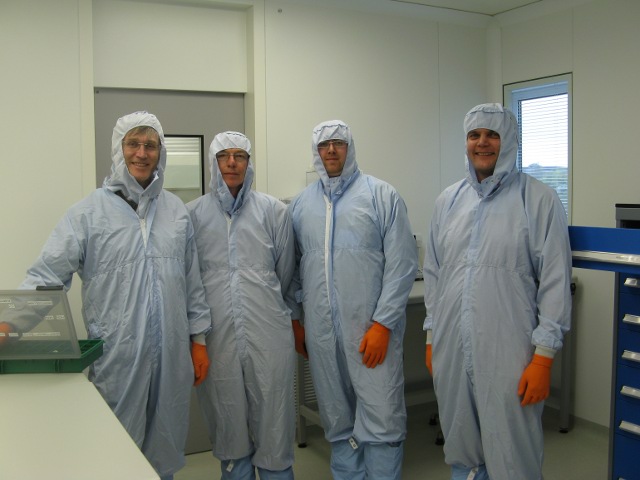 BIMS members viewing the OU's meteorite collection in a clean room.
After removing the clean room garments we were given a presentation on Dr Greenwood's work at the OU. He works predominantly on oxygen isotopes in meteorites and we were given considerable insight into the use of oxygen isotopes in classification. Much of this was framed within the context of the Almahata Sitta fall. Dr Greenwood showed considerable skill in making this complex area of research very accessible, I have gone back to look at those oxygen isotope ratio graphs in McSween with renewed interest and understanding!
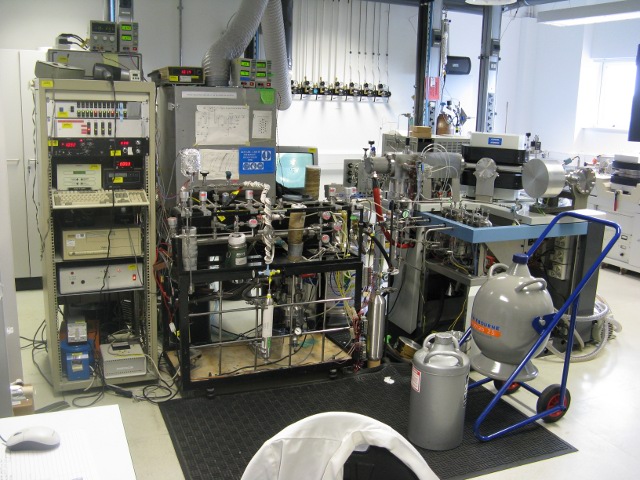 The OU oxygen isotope laboratory. In the centre is the apparatus for collecting the oxygen, on the right hand side is the mass spectrometer.
Following on from lunch we began visits to some of the labs at the PSSRI, beginning with the oxygen isotope laboratory. The foundation of all modern work on oxygen isotopes in meteorites was done by Robert N. Clayton and others, starting in 1973 through to his 1993 paper "Oxygen Isotopes in Meteorites" (Annual review of earth and planetary sciences. Vol. 21, p. 115-149) and beyond. At the OU the procedure involves vaporising a tiny (~2mg) powdered sample of a meteorite using a laser. The oxygen predominantly present in the sample's silicates is liberated using bromine pentafluoride (a technique also pioneered by Robert N. Clayton and Toshiko K. Mayeda, here). There are three isotopes of oxygen, oxygen-16 is the most common, with the other two isotopes (oxygen-17 and oxygen-18) being much more scarce. Once the oxygen has been liberated from the meteorite sample, any contaminants are removed, then a mass spectrometer is used to measure the relative abundance of each isotope. The ratios oxygen-17/oxygen-16 and oxygen-18/oxygen-16 are then calculated (these are known as delta17 and delta18 respectively). When a graph is plotted of delta17 against delta18 it is found that each classification of meteorites falls within a particular area of the graph. The distinction between many of the groups is so clear that this has become an excellent tool for classification, superseding the visual techniques relied upon in the past. Example graphs can be seen in the Oxygen Isotopes in Meteorites paper linked above, or for some nice colour examples see figure 11 on this page in "Encyclopedia of the Solar System" via Google books.
Interestingly all samples from Earth plot along a single straight line on this graph (the "Terrestrial Fractionation Line" or TFL), the minerals in CAI's (the irregular light coloured inclusions common in Allende and other CV3 meteorites) also plot in a straight line but completely separate to the TFL. Before isotopic analysis can be done any terrestrial oxygen must be removed from the sample, usually this oxygen will have bonded with iron in the meteorite. To remove iron oxides the sample is reacted with ethanolamine thioglycollate which selectively reacts with iron compounds, leaving the extraterrestrial oxygen present in the silicates untouched. This compound was originally developed for hair-perming, before its original scientific use for preserving (pyritized) fossils was developed by Cornish and Doyle of the NHM, London. You can read Cornish and Doyle's papers on the subject in The Geological Curator (Volume 3, Number 8, 1983) here and Palaeontology (Volume 27, Part 2, 1984) here. Following the oxygen isotope lab, Dr Jon Watson was able to provide insight in to the work done in the organic chemistry laboratory analysing the organic compounds present in meteorites.
 |
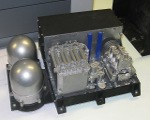 |
| Model of the instrumentation the PSSRI made for Beagle 2. |
Model of the Ptolemy instrument made for the Rosetta mission. |
Next we visited the spaceflight development laboratory and were shown examples of their work by Dr Geraint "Taff" Morgan and Dr Andy Morse. The OU have developed instruments for a number of space probes, including the ill-fated Beagle 2. More recently they produced the Ptolemy instrument for the Rosetta mission. Rosetta is set to rendezvous with comet 67P/Churyumov-Gerasimenko in 2014. At the time of writing it is about to be put into "deep sleep" to conserve energy, but last year the probe took some breathtaking images of asteroid 21 Lutetia, see here for some sample images. Rosetta carries a lander called Philae which houses the Ptolemy instrument. Ptolemy contains 26 sample ovens and a gas chromatograph-isotope ratio mass spectrometer (gc-irms) to enable it to do chemical and isotopic analysis of the comets coma and samples drilled from the comet itself. Amazingly the whole instrument weighs just 4.5kg despite doing work akin to the whole room full of apparatus we had seen in the oxygen isotope lab. The team that developed the instruments for Beagle and Rosetta are now using the same technology for Earth based applications from monitoring air quality in enclosed spaces to diagnosing medical conditions by "sniffing" patients breath or urine. Their medical applications already rival the current standard diagnosis techniques which in some cases are considerably more invasive. During this part of the day we were also lucky enough to meet Professor Colin Pillinger, if his name is unfamiliar to you (and since you're reading this page that seems unlikely!) watch this short video where he discusses the parallels between Darwin's Beagle and the Beagle 2 probe to Mars.
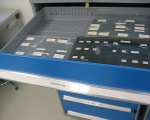 |
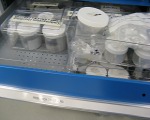 |
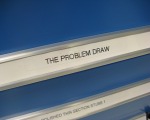 |
| Part of the research collection. |
Another drawer of carefully curated rocks from space. |
"The Problem Draw", we never found out what it contained! |
Finally, we had an opportunity to view the meteorite collection. The collection consists of several thousand specimens. It is a research collection, which means that the majority of specimens are small. As an example, for oxygen isotope work they would normally request a specimen in the region of 100mg. The collection is housed in a clean room, kept at positive pressure. The smaller samples were boxed and housed in well organised larger drawers (see images above). They have a notable collection of desert finds and were also involved in the Euromet Antarctic search for meteorites, there were several drawers containing specimens from Frontier Mountains. Most of the Antarctic specimens are actually quite small, as two examples pictured below demonstrate. We also saw some samples of Acfer 094 (C2-ung, also pictured below), this is considered one of the most primitive of all meteorites and is rich in presolar grains. Much of the 82g found has already been used by researchers around the world.
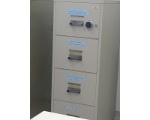 |
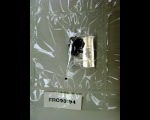 |
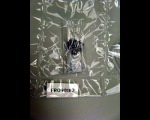 |
| Antarctic Finds |
FRO90194 (OC, provisional) 5.5g |
FRO90187 (Stone-uncl, provisional) 4.8g |
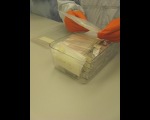 |
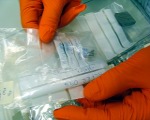 |
| Acfer 051-100 specimens. |
Acfer 094 (C2-ung) |
For the historians among you there was a large jar of the sediment collected by the Challenger expedition in the 1870's. In the time since it was collected the liquid had clearly managed to evaporate from the sealed jar, leaving a large lump of solid jar-shaped sediment that was much smaller than the jar it was in (this is visible in the image below). The information on the label show that the sample was collected around 1000km east of Bermuda in the Atlantic ocean at a depth of over 5km. Micro-meteorites were discovered in the sediments and studied at the time, you may recall our August '09 image of the month featured a slide from the NHM containing some of the micro-meteorites found by Challenger.
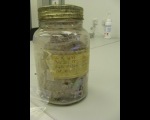 |
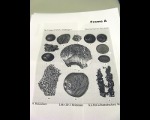 |
| Challenger expedition sediment. |
Image of micro-meteorites discovered in the Challenger sediments. |
I would again like to thank Dr Richard Greenwood for planning the visit and making us all so welcome on the day, he was generous with his time and expertise which was appreciated by all those who attended. I would also like to thank Dr Jon Watson, Dr Geraint "Taff" Morgan and Dr Andy Morse who each took time out from their day to speak to us.
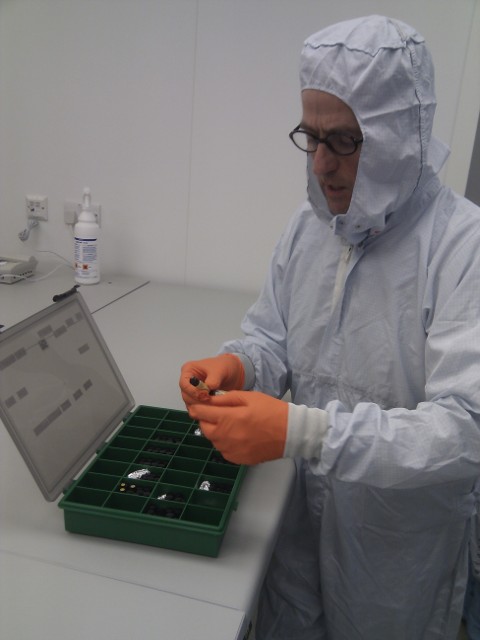 Dr Greenwood showing us some of the research samples. Image courtesy of Martin Goff.
Unless otherwise stated all text and images are (c)2011 M. Smith. Images were taken with permission from The Open University.
Additional Reading:
There are many sources linked from the text above, but you may also be interested to read the following:
|

